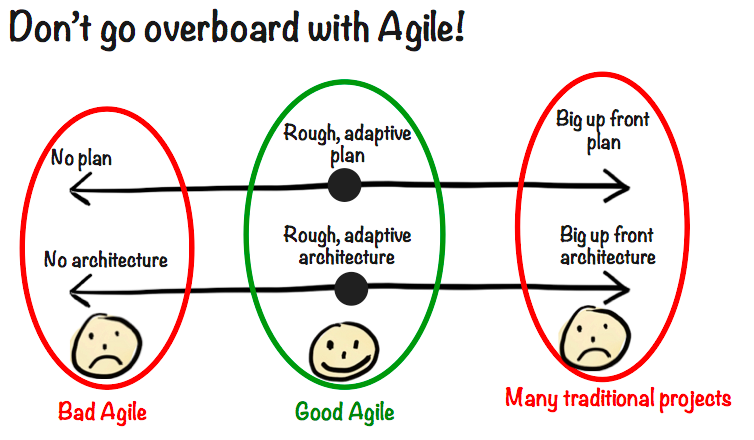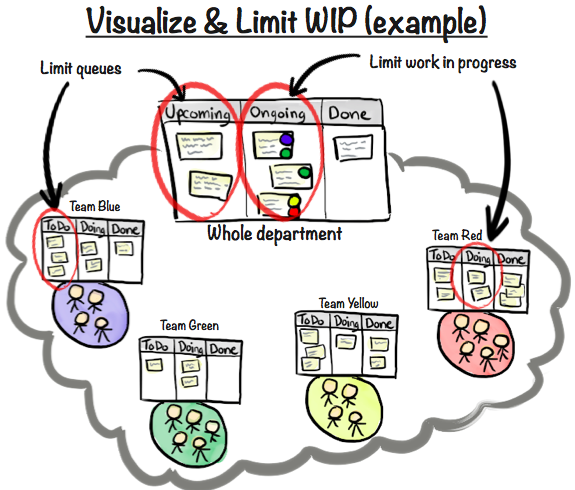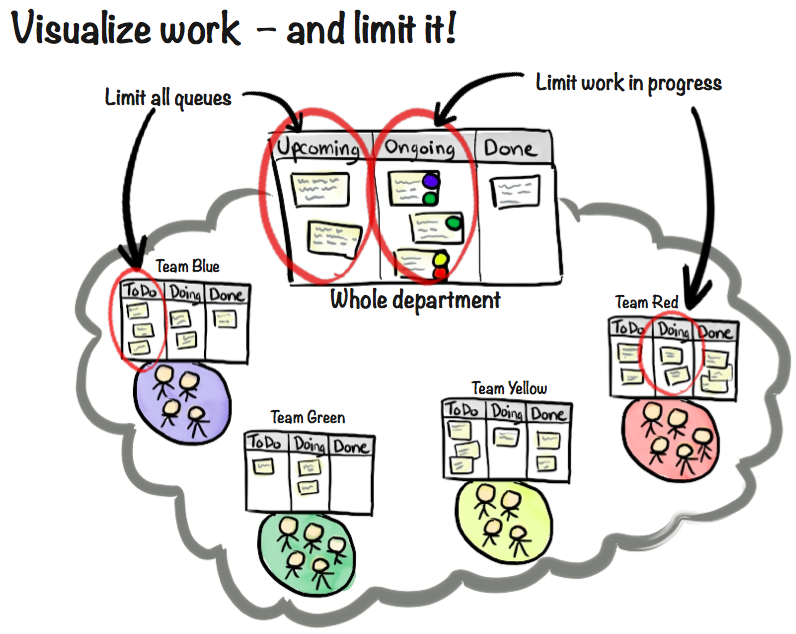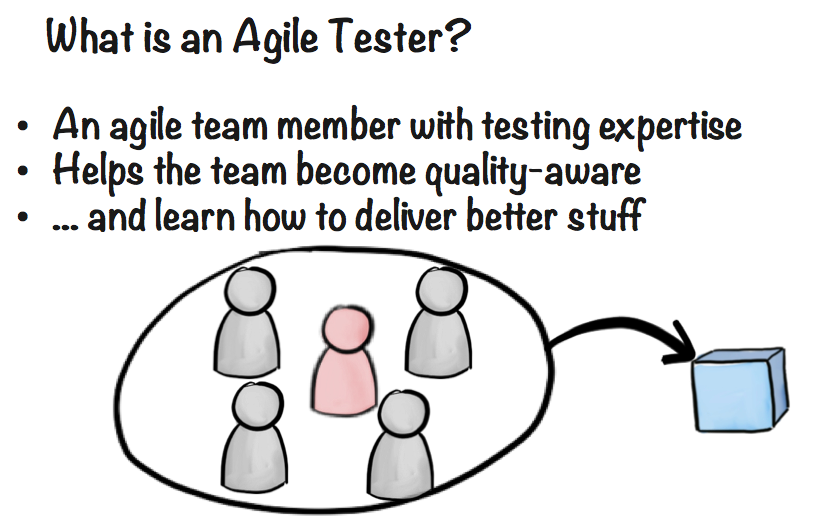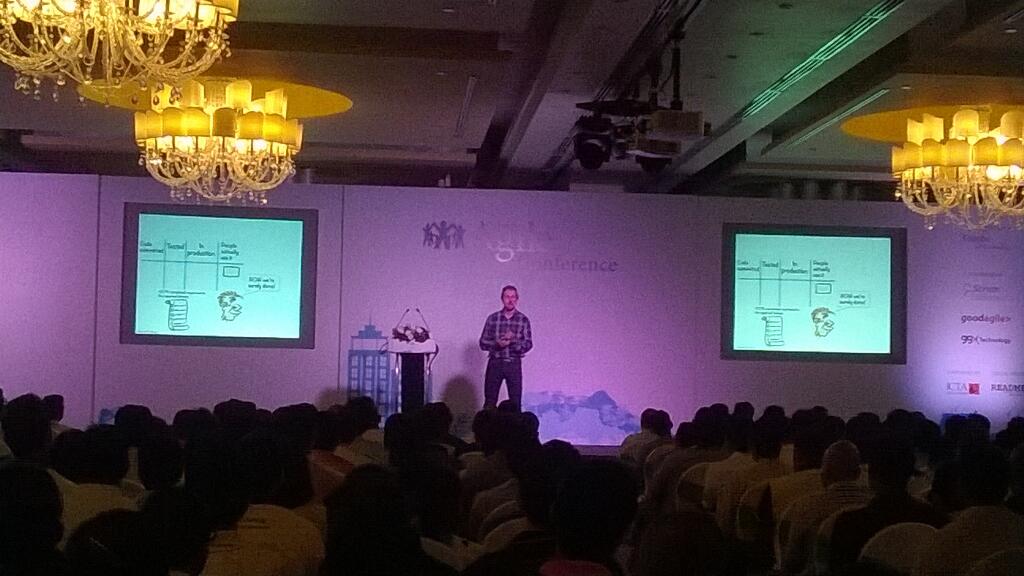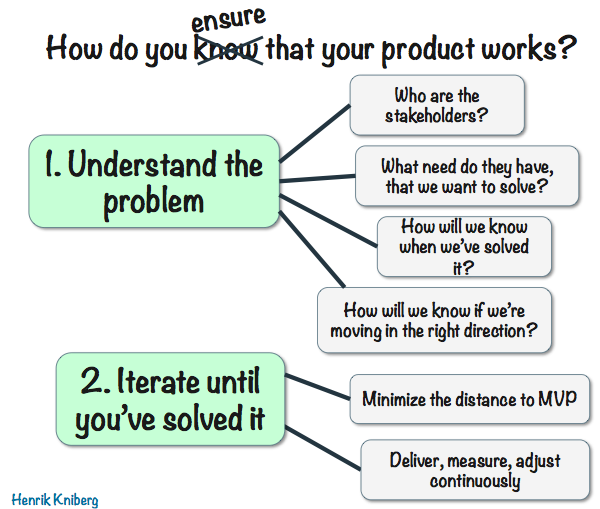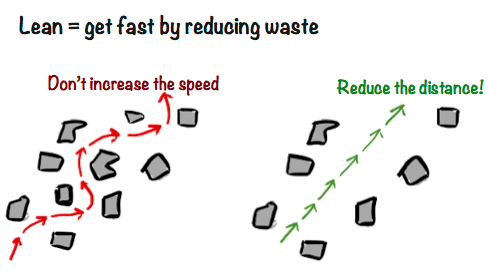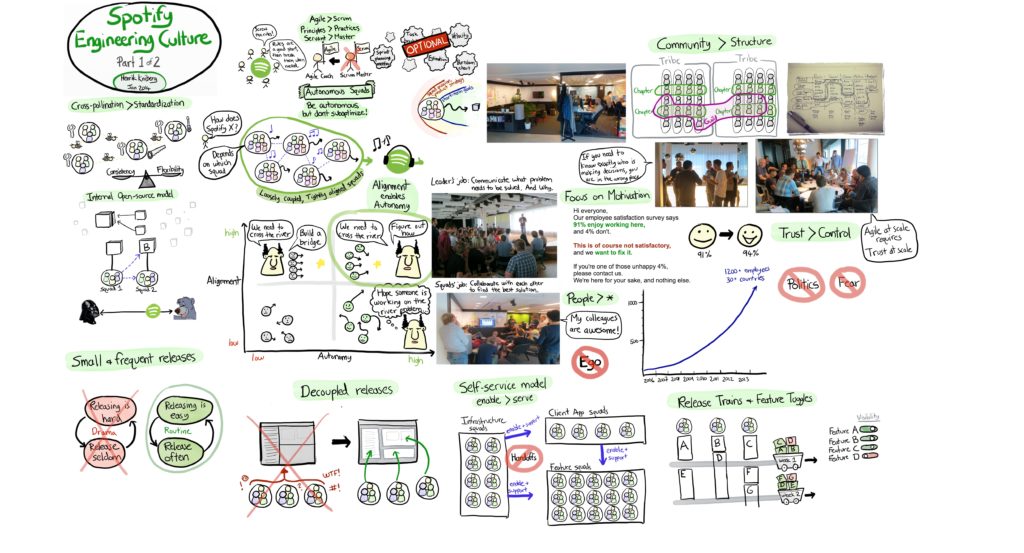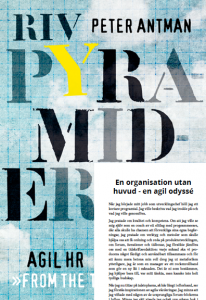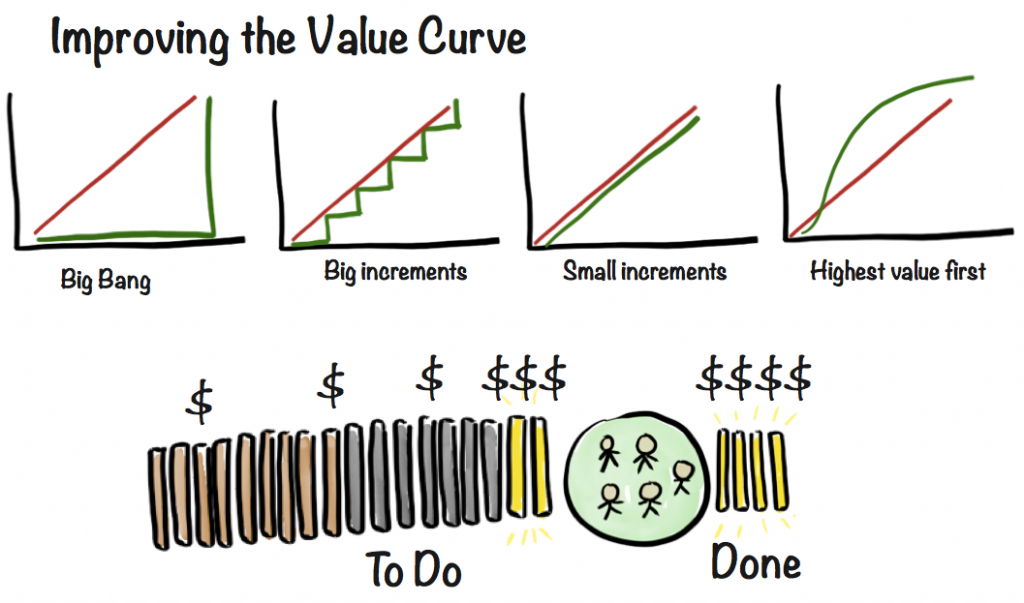Here are the slides for my talk “What is Scrum?” at KTH (Royal Institute of Technology). It was a guest talk at a course called Projektstyrning. Hoping to inspire young entrepreneurs to plant agile DNA in their companies from the very beginning. Last time I spoke at KTH was 6.5 years ago, that’s when I
Continue readingFacilitating the Elephant Carpaccio Exercise
One of the best exercises I know of on how to learn and practice User Story slicing techniques is the so called Elephant Carpaccio exercise. At Spotify it is something of a staple as it it is (often) used when introducing new employees (now a days). Facilitating the Elephant carpaccio exercise from Peter Antman The
Continue readingWIP and Priorities – how to get fast and focused!
(Translations: French)
Many common organizational problems can be traced down to management of Priorities and WIP (work in progress). Doing this well at all levels in an organization can make a huge difference! I’ve experimented quite a lot with this, here are some practical guidelines:
“As a, I want, So that” Considered Harmful
If you are working on an agile project, it is almost certain that you are using Stories to describe your backlog of work. It is another near-certainty that if you are using Stories, you write them down using this format:
“As a <user or stakeholder type>
I want <some software feature>
So that <some business value>”
As someone who cares about the state of agile practice, I want to offer some alternatives, so that agile teams remember that the point of the story is in the telling, not the template. The shared understanding comes from the conversation, not the card. By offering you different ways to ‘tell’ the story in its short written form, I hope you will be able to re-ignite a greater level of meaning, interest and engagement in your team’s discussions about the work they are doing to build great software that matters to people.
Spotify Engineering Culture (part 2)
Here’s part 2 of the short animated video describing Spotify’s engineering culture (also posted on Spotify’s blog). Check out part 1 first if you haven’t already seen it! This is a journey in progress, not a journey completed, so the video is somewhere between “How Things Are Today” and “How We Want Things To Be”. Here’s the whole drawing:
Continue readingLet the User Story Flow
One of my biggest surprises when I first met the squads I where going to work with at Spotify was that none of them were using User Stories. At first I observed to see their alternative. Unfortunately there was none. Instead most of the work got done as big chunks of work (what I would tend to call Epics) that was sliced into a todo-list of tasks (named that way by the developers) and also divided according different platforms.
Squad focus on technical tasks
A typical board contained one or more business cases and lanes for each developer/platform with tasks that were executed upon. These big “busses” where on the board blocking other works for weeks, which of course meant there needed to exist one or more emergency lanes for all expedite work (in the long run, most work).
This is a setup that does not foster collaboration, focus on value and art-of-the-possible. From an agile fluence point of view I would say it is a way of working that does not even reach fluence level 1 (Christian and I will describe agile fluence in more depth in a follow up blog post). From my experience focusing on User Stories is a great way of fostering the above values, and reach fluence level 1.
Agile @ Scale (slides from Sony Mobile tech talk)
Here are the slides from my tech talk Agile @ Scale at Sony Mobile. Full house & very high level of engagement, I was impressed by this crowd! And thanks for the awesome recommendation on LinkedIn 🙂 Some sample pics below:
Continue readingLean Canvas – an hypotheses board
As so many others I’m inspired by the book Lean Startup. The idea of experimenting with your business model and deliver just the bare stuff needed to validate (or actually try to refute) your business hypothesis is so enticing. But how do you do that when you are one of 50 or 100 teams? How do you do that when the teams are not even using User Stories? How do you do that when daily work is done on a Kanban board only showing tasks?
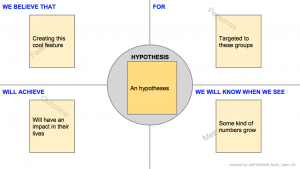
One part of a possible solution is to find a way of visualizing the business case. A popular approach has become setting up a business board, often called a Lean Canvas. I wanted to try something like that. But going trough all the different variants I could find, no one was good enough in itself. I wanted to get the same feeling as with User Stories: a simple formula that everyone can understand and use as soon as the formula is presented.
My Spotify tools
Last week i quit my assignment at Spotify. I was there to help and act as a stand-in for Joakim Sundén while he was on paternity leave. He’s now back in the saddle as Agile Coach in the More Than Music Tribe. I had the pleasure to work closely with the Agile Coach Christian Vikström on Spotify and together we have been coaching the Browse, Growth and Customer Support squads. A was also a member of the tribe management team, and together we did some new interesting stuff.
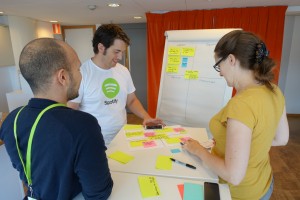
It’s has been fascinating and fantastic to work with such dedicated people and a product that has such a traction. Spotify is also really trying to build an awesome and agile organization and culture that can win and sustain in the long run. What is there to do at such a fantastic company? That’s a reasonable question. A lot I discovered. Spotify is shock full of super smart people, but many of them has not worked there for long, many of them has not worked long at all, teams have been newly formed and are under constant change. Simply put: even Spotify needs a lot of basic agile coaching.
When I now look back at what we did during these last 8 month I see a lot of tools and experiences that I think others also can find useful. During the next couple of month I will share them through this blog. Hope you will find them useful. Here’s the planned list:
What is an Agile Tester? Slides from my Sri Lanka talk.
Here are the slides for my talk What is an agile tester from the Colombo Agile Conference in Sri Lanka.
How do you know that your product works? Slides from my Sri Lanka keynote.
Here are the slides for my keynote How do you know that your product works, from the Colombo Agile Conference in Sri Lanka.
Focus – slides from my talk at Projektnäring
Here are the slides for my talk “Focus” at Projektnäring. Great group, lots of energy in the room. Had lots of great conversations with people. Thanks for attending!
Sample pics:
Stop-the-line spoken word performance
På Agila Sverige 2012 höll jag min första ignite i form av en Majakovski- och Bob Dylan-inspirerad Spoken World performance om hur vi på Polopoly skapade kvalitet genom extremt fokus på automatiserade tester och en stoppa-bandet-kultur. Förra veckan fyllde konsultbolaget Adaptiv 5 år och firade genom att låte en utvald skara Agila Sverige-talare reprisera sina
Continue readingLearning flow with the Lean Dot Game
Yesterday we had one of our regularly occurring so called Agile Lunch & Learn in the tribe at Spotify I currently work. We wanted to make the lunch about why it is often better not to work and focus on flow than to maximize your work and focus on resource efficiency. I searched for something in the Crisp bag of games. Pass the pennies – more about big batches. Kanban tothpicks – to many rounds and variables. Folding envelopes – again more batches. Eventually I found the Lean Dot game.

What a find! This game will be with me for a long time. The best flow game there is, with extremply simple props: post-it notes and colored dots. You can run it in an hour and get tons of experiences and stuff to discuss, such as:
- Why it’s better to slow down
- Adapt to bottlenecks
- Batch sizes
- Little’s law illustrated
- Waste and inventory
- Customer collaboration
- In process testing
- And more, and more, and more…
Spotify Engineering Culture (part 1)
Here’s a short animated video describing Spotify’s engineering culture (also posted on Spotify’s blog). See also Part 2. This is a journey in progress, not a journey completed, and there’s a lot of variation from squad to squad. So the stuff in the video isn’t all true for all squads all the time, but it appears
Continue readingA bug is just an unwritten test that failed
In the first week of March I attended two Spotify unconferences about Continuous Deliver and Quality (which I also had the pleasure to facilitate). I am amazed on how many we were (people had flown in from a lot of other places), the energy in the room, the quality of the discussions, and the massive
Continue readingWhy I prefer ToDo over Trello for agile teams
The Gist
- ToDo has a flow. It knows about cycle times and about being DONE. Trello does not.
- ToDo has Planning Poker Estimates. Trello does not have any estimates.
- ToDo has automatic burn up charts. Trello does not.
- ToDo has swim lanes which groups cards by your dimensions. Trello does not.
- ToDo has Work-In-Progress limits. Trello does not.
- ToDo has upgrade possibilities to the full tool set of Projectplace. Trello has a bunch of plugins from different vendors of various quality.
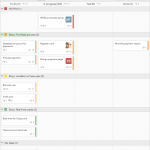
Already convinced? Sign up for ToDo by Projectplace! Want to know more? Read on.
Delagardrivet och upplevelsebaserat lärande
I juni kommer min kollega Jimmy Janlén och jag hålla kurs i deltagardrivet och upplevelsebaserat lärande. Vill vi hjälpa andra att upptäcka och praktisera sätt att skapa sant engagerande och lärande undervisning, presentationer och workshops. Kanske slipper ni då mina egen långa resa bort från katedern.

Så vitt jag minns det var jag 24, kanske 25 år. Jag och min vän Göran hade blivit inbjudna att hålla föredrag inför en större samling människor. Det hade jag aldrig gjort förut. Visst var jag van att prata inför andra människor, från seminarierna på universitetet till redaktionsmötena på vår lilla tidsskrift, men inte att hålla tal. Jag gjorde det som kändes säkrast. Jag skrev ett tal och läste sedan upp det.
Förutom att det tog jättelång tid att skriva talet, så kändes det inte bra att stå där och läsa rakt upp och ner. Visst försökte jag läsa med inlevelse och dramatik, ungefär som när man läser högt för barnen, men det kändes ändå inte bra. Höll inte åhörarna på att somna? Lärde de sig alls något? Det går att trollbinda en publik med högläsning, om man berättar en riktigt bra historia. Göran var bra på det, men inte jag. Något behövde jag göra annorlunda.
Agile People i Göteborg
Den 3:e december var jag inbjuden till nätverket Agile People i Göteborg för att tala om min bok Riv pyramiderna igen. Det var god uppsluting av människor som ville prata om hur HR påverkas av när en organisation börjar använda agila värden och principer från lean; och hur HR själv kan inspireras av ett iterativt
Continue readingCustomizing the Google Spreadsheet Story Card Generator
At my current project we use a Google spreadsheet to manage our backlogs. This works really well for storing and sharing the backlog, but it’s not very good for visualizing it. So we print out the stories on cards by copying and pasting each row into a document table cell and reformatting, adding extra labels, and manually inserting priority. Well, that’s what we did the first couple of times, until I found David Vujic’s fantastic Index Card Generator for Google spreadsheets (http://davidvujic.blogspot.se/2011/06/visa-vad-du-gor-eller-dude-wheres-my.html).
Except, we have multiple backlogs in one sheet, our column names aren’t the same, and we use a different layout for the cards. Here’s how we customized David’s script!Continue reading
Visa att du verkligen kan programmera
I det nya kapitlet “Hitta rätt folk – konsten att rekrytera” i boken Riv pyramiderna igen – agil HR from the ‘trenches'” skildrar jag hur vi skapade en för oss passande strategi och metod för att kunna rekrytera rätt folk till våra team. Här kan du läsa ett utdrag:
“Så vitt jag minns det kom förslaget till nästa initiativ från en diskussion om rekrytering med teamen. Minns jag rätt tyckte man att min utfrågning inte gav tillräcklig bra underlag för att verkligen förstå om kandidaterna var bra programmerare. Vi brukade förvisso be om arbetsprov, men många hade inga sådana av med tillräcklig verkshöjd och det var också svårt att utveckla någon form av rimliga kriterier som kunde användas att bedöma kodexempel av väldigt olika sort.
Continue reading
Det är inte bara din ScrumMaster som behöver förstå vad “agile” är!
Återigen har ni diskussionen om “working software over comprehensive documentation” verkligen betyder att man inte behöver dokumentera någonting alls. Eller diskussionen om det är ok att förlänga sprinten med några dagar för att hinna klart den sista fixen på den där storyn. Eller diskussionen om vad det egentligen innebär att vara “lean”. Känner du igen dig? Kan det vara så att alla har nytta av att ha samma grundförståelse av centrala begrepp i och runt “agile”? Läs vidare för ett enkelt sätt att skaffa den kunskapen!Continue reading
Acceptance-Test Driven Development from the Trenches
Getting started with ATDD Have you ever been in this situation? Then this article is for you – a concrete example of how to get started with acceptance-test driven development on an existing code base. Read on.
Continue readingNytt matigt kapitel till Riv pyramiderna igen
På ett bräde blev boken Riv pyramiderna igen dubbelt så tjock (222 sidor) med det nya kapitlet “En organisation utan huvud – en agil odyssé“. I den gör vi en historisk, praktiskt och teoretisk resa från apache-indianerna, över Ford, Toyota, Lean, Scrum, Agile, flödeseffektivitet, Hegel, Kant, hur det påverkade oss och mycket mer. Slutstation:en massiv
Continue readingCulture > Process (Paris Scrum Gathering keynote)
Here are the slides for my keynote “Culture > Process” at the Paris Scrum Gathering. Amazing level of enthusiasm in the room, seems like this kind of stuff was exacty what people were looking for. Happy to see the ideas take such strong hold!
- Video recording part 1 (starts at 0:30)
- Video recording part 2
Bokomslag till Riv pyramiderna igen
I dagarna fick jag bokomslaget till boken Riv pyramiderna igen – Agil HR ‘from the trenches’ jag håller på att skriva på Leanpub. Jag är otroligt nöjd med det. Omslaget är gjort av Lisa Zachrisson. Så här skriver hon om tankarna bakom formgivningen: Jag tyckte att titeln skulle vara stor då det fungerar bra när
Continue readingInterview with Peter Antman on software development
In May this year I was interviewed at the SmartBear MeetUI user conference in Stockholm about my background as a journalist, Linux and open source, software development in general and testing more specifically. Here’s a post containing the video and interviews with the other speakers at the conference. Interview with Peter Antman
Continue readingNy bok: Riv pyramiderna igen – Agil HR ‘from the trenches’
Idag publicerade jag den första versionen av min nya bok Riv pyramiderna igen – Agil HR ‘from the trenches’. Boken tar sin utgångspunkt in min blogserie om Agil HR, som härmed fortsätter i bokform på Leanpub. Jag räknar med att den är cirka 50 – 70 procent klar och kommer färdigställas under hösten. Köp nu,
Continue readingAgile event @ major swedish bank
Yesterday I spent a very inspiring day with a big swedish bank, doing agile intros with 1200 people. We had developers, designers, testers, C-level execs, project leads, pretty much every role represented. The CEO opened with words about why they are determined to go all-out agile, and we had a speaker from another even bigger company describe their ongoing agile journey and amazing results so far. Very interesting. And best of all – no roadmap or other fake attempts at pretending that we know what the journey is going to look like. It was clear that this is a bumpy ride and that change will have to evolve gradually from bottom as well as from top.
Elephant Carpaccio facilitation guide
The Elephant Carpaccio exercise is a great way for software people to practice & learn how to break stories into really thin vertical slices. It also leads to interesting discussions about quality and tech practices. The exercise was invented by Alistair Cockburn. We’ve co-facilitated it a bunch of times and encourage people to run it
Continue reading